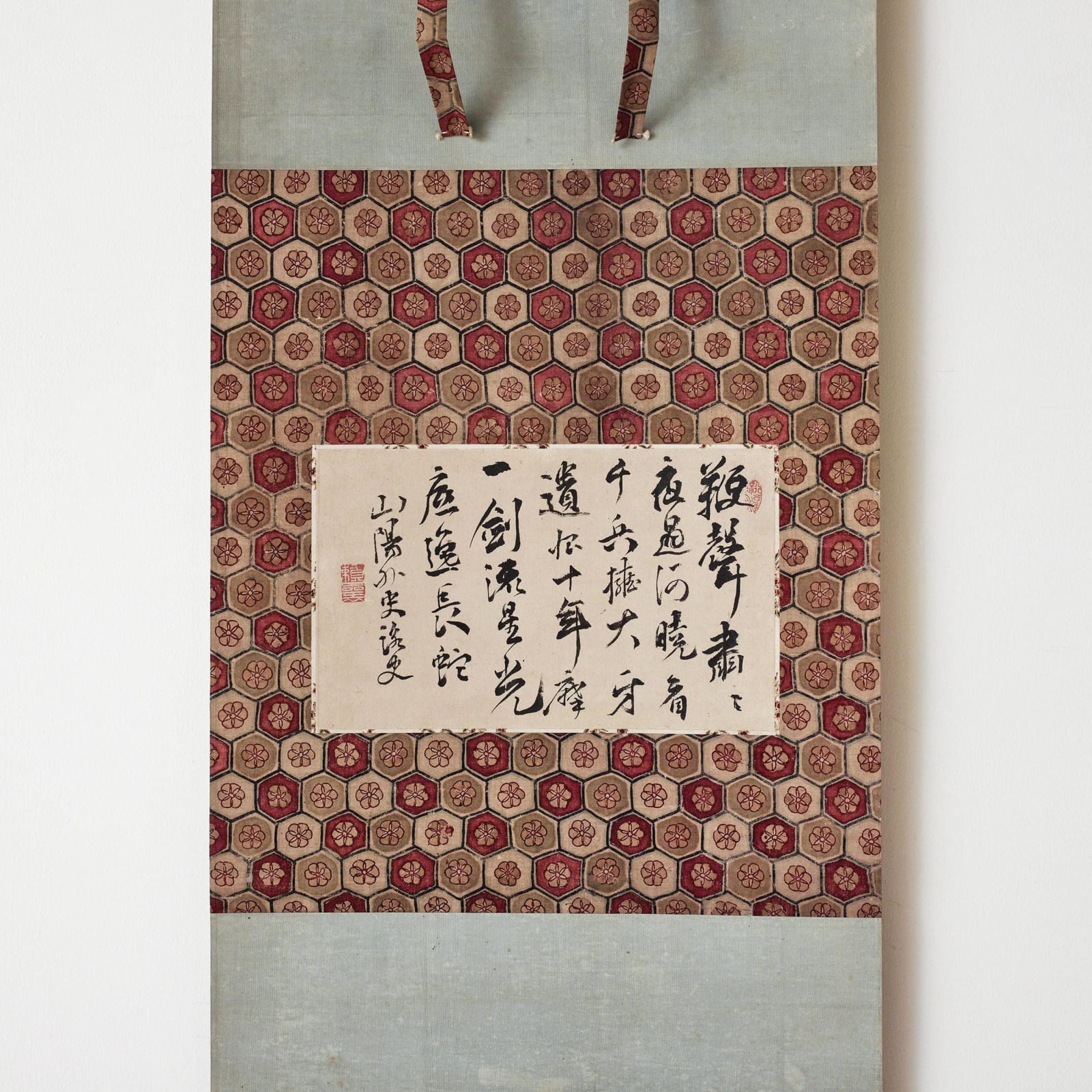Rai San’yō (1780–1832)
Poem Celebrating Kawanakajima
Ink on paper, hanging scroll
With box authentication by Kojima Kasuke, double box
Seals: Koun ryusui, Rai Noboru
19 x 32 cm
113 x 46 cm (overall)
With box authentication by Kojima Kasuke, double box
Seals: Koun ryusui, Rai Noboru
19 x 32 cm
113 x 46 cm (overall)
Further images
Provenance
Collection of Yokoe ChikkenCollection of Ishibashi Tokujiro
Exhibitions
Chikken zohin tenkan. Tokyo: Tokyo Art Club; Osaka: Osaka Bijutsu Kurabu, 1935.
The poem inscribed on this scroll addresses the famous battles of Uesugi Kenshin and Takeda Shingen at Kawanakajima. It is one of Rai San’yo’s most well-known poems, and also familiar as an example for learning the Japanese recitation of poetry originally written in Chinese. Moreover, this scroll is often referenced as representative of San’yo’s calligraphy style and can thus be considered a prominent work. The poem translates:
The sound of a whip on a horse resonating in the quiet of the night,
when crossing the river
Dawn breaks, and before one’s eyes thousands of soldiers of the enemy
assembling around the banner of their general
The bitterness of ten years held inside, sternly polishing one’s sword
Like a falling star the blade he wielded reflecting the light,
And yet he escaped an endless line of cunning enemies
The Battles of Kawanakajima took place over an extended period of about twelve years from 1553 to 1564 in the area of northern Shinano (now Nagano Prefecture). Despite of five major confrontations during that time, no decisive victory could be achieved by either party. The fiercest battle was the fourth one that took place in 1561 when Kenshin and Shingen fought each other directly, which is the event recounted in the above poem.
San’yo style is mostly semi-cursive gyosho with some elements of cursive script (sosho); lines that connect characters into a continuous flow are not used. The size difference of characters is considerable, which gives his style a certain awkwardness. The first two characters bensei (sound of a whip) and the word ikken (blade) are particularly large and impressive, conveying the writer’s elevation of spirits when he came along writing these particular words.
The present scroll was once in the possession of Yokoe Manjiro (known as Chikken), the owner of an antiques store in Osaka and practitioner of sencha (green leaf tea). Later, it was acquired by Ishibashi Tokujiro, entrepreneur and elder brother of Ishibashi Shojiro, the founder of what is today the Bridgestone Corporation. The box inscription was made at the request of Chikken by the owner of a store for tea ceremony goods, Kojima Kasuke (Beisankyo), who had a reputation as a well-known connoisseur.
Rai San’yo (confucian scholar; 1780–1832)
Late Edo-period Confucian scholar and a supporter of the restoration of imperial power. Born in Osaka as the son of the Hiroshima-based Confucian scholar Rai Shunsui, he began his education in Hiroshima but soon moved to Edo to study with Bito Jishu and Hattori Rissai. He later settled in Kyoto, where he operated a private school and a calligraphy studio, called Sanshi Suimeisho. In addition, San’yo traveled extensively throughout Japan and maintained a large network of literati friends. Among his most renowned works are Unofficial History of Japan (Nihon Gaishi), Records of Japan’s Government and various anthologies of his poetry.
The sound of a whip on a horse resonating in the quiet of the night,
when crossing the river
Dawn breaks, and before one’s eyes thousands of soldiers of the enemy
assembling around the banner of their general
The bitterness of ten years held inside, sternly polishing one’s sword
Like a falling star the blade he wielded reflecting the light,
And yet he escaped an endless line of cunning enemies
The Battles of Kawanakajima took place over an extended period of about twelve years from 1553 to 1564 in the area of northern Shinano (now Nagano Prefecture). Despite of five major confrontations during that time, no decisive victory could be achieved by either party. The fiercest battle was the fourth one that took place in 1561 when Kenshin and Shingen fought each other directly, which is the event recounted in the above poem.
San’yo style is mostly semi-cursive gyosho with some elements of cursive script (sosho); lines that connect characters into a continuous flow are not used. The size difference of characters is considerable, which gives his style a certain awkwardness. The first two characters bensei (sound of a whip) and the word ikken (blade) are particularly large and impressive, conveying the writer’s elevation of spirits when he came along writing these particular words.
The present scroll was once in the possession of Yokoe Manjiro (known as Chikken), the owner of an antiques store in Osaka and practitioner of sencha (green leaf tea). Later, it was acquired by Ishibashi Tokujiro, entrepreneur and elder brother of Ishibashi Shojiro, the founder of what is today the Bridgestone Corporation. The box inscription was made at the request of Chikken by the owner of a store for tea ceremony goods, Kojima Kasuke (Beisankyo), who had a reputation as a well-known connoisseur.
Rai San’yo (confucian scholar; 1780–1832)
Late Edo-period Confucian scholar and a supporter of the restoration of imperial power. Born in Osaka as the son of the Hiroshima-based Confucian scholar Rai Shunsui, he began his education in Hiroshima but soon moved to Edo to study with Bito Jishu and Hattori Rissai. He later settled in Kyoto, where he operated a private school and a calligraphy studio, called Sanshi Suimeisho. In addition, San’yo traveled extensively throughout Japan and maintained a large network of literati friends. Among his most renowned works are Unofficial History of Japan (Nihon Gaishi), Records of Japan’s Government and various anthologies of his poetry.









